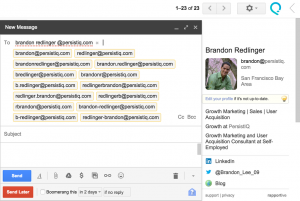We can use the carousel to highlight products, live real-time feeds and interactive forms to be more creative with email; but be sure to A/B test to measure their value for each campaign.
Gmail turned 15 earlier this year — and with it, the Accelerated Mobile Pages (AMP) feature is now a year old. AMP functionality was built to allow brands to be more creative with their email marketing strategies, offering increased opportunities for more engaging, interactive and streamlined experiences for Gmail users.
With AMP, marketers can code emails that allow Gmail subscribers to interact with email content without leaving Gmail to improve the email experience. The benefits of this are extensive. The functionality at its finest could enable marketers to build interactive content to stay relevant and reduce friction in the purchase process and ultimately increase conversions.
However, many of the concerns I noted when AMP was first released a year ago still remain and many marketers caution against using AMP. It’s easy to understand why.
Stringent coding guidelines for AMP mean that HTTML/CSS tactics will not work — you’ll need to use a separate MIME (Multi-Purpose Internet Mail Extensions) type for any email with AMP support. With AMP coding less flexible than traditional HTTML/CSS, it may take longer for your in-house team to embrace the feature. In addition, the switch to AMP entails more time in the quality assurance and testing process for each email you send out.
In short, incorporating AMP into your email strategy is no simple endeavor. And marketers might initially balk at investing the time and money in a tactic that will only affect a certain segment of their audience: Gmail users. But remember, Gmail continues to surge in market share — up 25% YOY. In fact, Gmail is now the top email client across devices as of this post. So despite its difficulties, AMP is worth a look given the potential for your brand.
How much? That remains to be seen, but AMP is ripe for testing. Start experimenting with low-risk use cases that are relevant to the subscribers in your industry to determine if it’s worth the level of effort. At the very minimum, as an early adopter you’ll reap the benefits of standing out in an already crowded inbox piquing your subscriber’s interest.
Test these low-risk AMP use cases
Now that AMP for Gmail has had some time to evolve, the pros outweigh the cons. Not only do Gmail users make up a large percentage of most marketers’ subscribers, but also the feature allows for marketers to get more creative with their emails, ultimately improving the customer experience and boosting engagement. Here are some specific, low-risk ways email marketers can use AMP for Gmail:
Use the carousel feature to highlight products: Using AMP’s carousel feature, retailers can showcase multiple images of products and create more engaging experiences personalized to each user. With the carousel, marketers have the power to provide subscribers with more information along with a more interactive experience directly within Gmail. This increases the fun aspect of design and allows subscribers to conduct more research prior to leaving Gmail. Since this feature has already proven popular on social media platforms like Facebook and Instagram, it’s easy to see the appeal for email across a range of industries. Travel and retail industries seem most ripe for this feature.
Allow customers to access info in real-time: Travel brands like airlines and hotels benefit from AMP’s ability to incorporate live real-time feeds of available rooms or plane tickets directly within an email. Using an AMP-supported email, consumers can choose dates and compare rates without leaving to go to your website. This minimizes the friction in the process and discourages customers from checking out your competitors or even purchasing your own tickets from third-party sites (which limits the data you can collect from them). Retail brands can incorporate a similar real-time content strategy as hot products go out of stock, offers change, or content becomes irrelevant due to the subscriber’s current location.
Enable interactive forms for sign-ups, applications and more: AMP allows you to gain more information than ever from your customers since they can interact directly within your messages. Financial services companies, for instance, can use forms to allow customers to apply for loans, credit cards, or refer friends to credit cards. Or, why not use it to survey customers about their preferences about anything from the products you’re selling to their general interests?
While these are just a few use cases, AMP features are versatile and powerful — and in the end, they could become another tool for improving the effectiveness of your email marketing strategy and ultimately making your subscribers lives better.
Same as always, what works for one audience won’t work for another so if you use AMP be sure to A/B test and keep track of the additional time you’ve invested to measure the worth. If it turns out to be another Google+, well you’ll know pretty quick not to waste your money and time. But if it works, that time and investment will have you ahead of the pack reaping the rewards for quarters to come.
Opinions expressed in this article are those of the guest author and not necessarily Marketing Land. Staff authors are listed here.
Marketing Land – Internet Marketing News, Strategies & Tips
(47)





